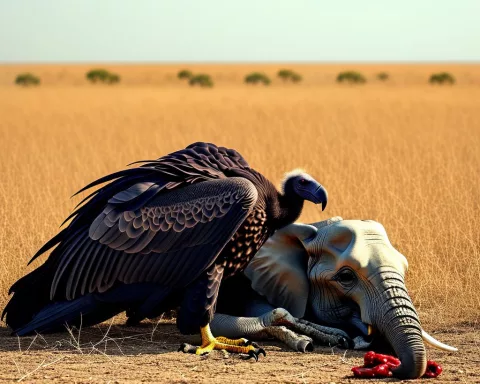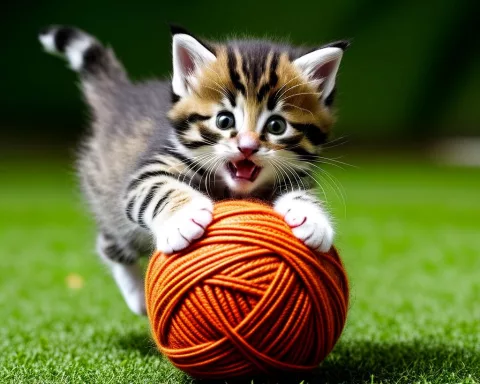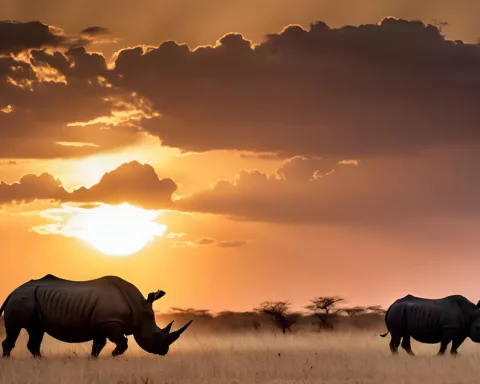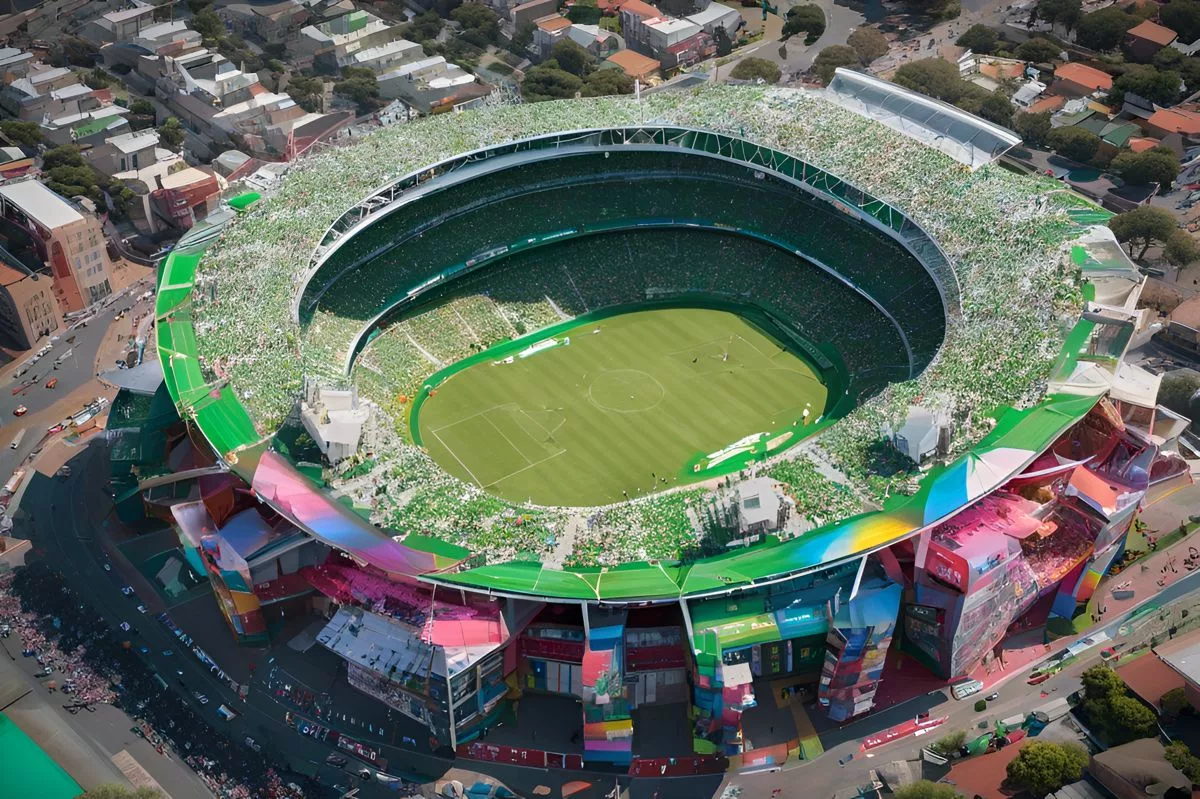A young white rhino calf was rescued by Care for Wild sanctuary in Kruger National Park after losing its mother. The sanctuary collaborated with the park’s veterinary squad to transport the calf using specially designed suspension ropes. The calf’s recovery was aided by a fellow resident, Dianna, who demonstrated remarkable empathy towards her fellow orphans. This uplifting story highlights the priceless work performed by sanctuaries like Care for Wild, and their dedication to preserving wildlife.
A young white rhino calf was rescued by the Care for Wild sanctuary in Kruger National Park after losing its mother. The sanctuary collaborated with the park’s veterinary squad to sedate and transport the calf using specially designed suspension ropes. Once at the sanctuary, the calf underwent comprehensive treatment, including the use of beneficial bacteria from a donor rhino’s gut to cultivate a healthy microbiome. The calf’s recovery was aided by Dianna, a fellow resident of the sanctuary, who demonstrated remarkable empathy and a motherly instinct towards her fellow orphans.
A Timely Discovery
Within the expansive landscape of Kruger National Park, a young white rhino calf, merely eighteen months old, found itself alone and exposed after losing its mother. Fortune smiled upon the calf when it was spotted and safeguarded by the acclaimed wildlife refuge, Care for Wild, revered for their dedication to conserving endangered animals. This fortunate incident not only procured the calf’s rescue but also stimulated the growth of an unusual yet inspiring relationship.
Navigating the Rescue Operation
The rescue mission stood as an exhibition of thorough planning and collaboration, reflecting the sanctuary’s unwavering commitment to animal protection and conservation. The Kruger National Park’s veterinary squad, aware of the potential field risks, collaborated with Care for Wild. The task was daunting. The calf’s massive size ruled out the option of helicopter transportation, while a ground retrieval would have consumed several valuable hours.
In a testament to their ingenuity and resourcefulness, the sanctuary, acknowledging the urgency of the matter, decided to sedate the calf and transport her using specially designed suspension ropes. Despite its unorthodox nature, the operation was a triumph, skillfully undertaken by an adept pilot and a well-trained veterinary team, under the watchful eye of Petronel Nieuwoudt, the sanctuary’s founder and CEO.
Calf Care in the Sanctuary
Upon her arrival, the calf was ushered into the Juvenile Intensive Care Unit, an expert facility designed to attend to the needs of larger, older orphaned animals. Here, the calf was subjected to a variety of treatments, ranging from routine temperature regulation and blood sugar monitoring to various tests. The team introduced an innovative treatment method, employing beneficial bacteria from a donor rhino’s gut to cultivate a healthy microbiome in the calf. This approach was essential for boosting her overall health during this period of immense stress and transition.
The treatment plan went beyond addressing physical ailments, with the team performing therapeutic limb massages to improve blood circulation and relieve lactic acid accumulation in the calf’s muscles. This comprehensive approach, which incorporates both physical and psychological healing methods, emphasizes the sanctuary’s commitment to the holistic wellness of their animals.
The Power of Companionship
Adding warmth to the narrative, Dianna, a fellow resident of the sanctuary, assumed a pivotal role in aiding the calf’s recovery. An orphan herself, Dianna has always demonstrated remarkable empathy and a motherly instinct towards her fellow orphans. Her contribution to the calf’s rehabilitation process has been critical. It is common for young orphaned animals to struggle with their mother’s absence, often leading to refusal to eat and severe depression. The comfort and support provided by Dianna could be a lifeline for the calf.
When Dianna was introduced to the calf after her condition stabilized, the calf showed initial hesitance. However, she was soon comforted by Dianna’s serene presence and gentle touch. Within a short span, they were observed sharing warm interactions, with the calf trailing behind Dianna and rubbing her body against Dianna’s face.
Lessons from the Rescue
This uplifting story highlights the priceless work performed by sanctuaries like Care for Wild. Their dedication to rescuing, rehabilitating, and preserving wildlife guarantees the survival and welfare of endangered species such as the white rhino. The narrative of the rescued calf and her evolving bond with Dianna serves as a tribute to nature’s resilience, while reminding us of the significant role humans can play in its preservation.
What happened to the white rhino calf?
The young white rhino calf was rescued by the Care for Wild sanctuary in Kruger National Park after losing its mother. Once at the sanctuary, the calf underwent comprehensive treatment, including the use of beneficial bacteria from a donor rhino’s gut to cultivate a healthy microbiome. The calf’s recovery was aided by Dianna, a fellow resident of the sanctuary, who demonstrated remarkable empathy and a motherly instinct towards her fellow orphans.
How was the white rhino calf rescued?
The rescue mission of the white rhino calf stood as an exhibition of thorough planning and collaboration, reflecting the sanctuary’s unwavering commitment to animal protection and conservation. The Kruger National Park’s veterinary squad, aware of the potential field risks, collaborated with Care for Wild. The sanctuary decided to sedate the calf and transport her using specially designed suspension ropes. The operation was a triumph, skillfully undertaken by an adept pilot and a well-trained veterinary team, under the watchful eye of Petronel Nieuwoudt, the sanctuary’s founder and CEO.
What treatments did the white rhino calf receive at the sanctuary?
Upon her arrival, the calf was subjected to a variety of treatments, ranging from routine temperature regulation and blood sugar monitoring to various tests. The team introduced an innovative treatment method, employing beneficial bacteria from a donor rhino’s gut to cultivate a healthy microbiome in the calf. The team also performed therapeutic limb massages to improve blood circulation and relieve lactic acid accumulation in the calf’s muscles.
Who helped the white rhino calf during her recovery?
Dianna, a fellow resident of the sanctuary, assumed a pivotal role in aiding the calf’s recovery. An orphan herself, Dianna has always demonstrated remarkable empathy and a motherly instinct towards her fellow orphans. Her contribution to the calf’s rehabilitation process has been critical. Dianna’s comfort and support were a lifeline for the calf during her transition into the sanctuary.
Why is this story uplifting?
This uplifting story highlights the priceless work performed by sanctuaries like Care for Wild. Their dedication to rescuing, rehabilitating, and preserving wildlife guarantees the survival and welfare of endangered species such as the white rhino. The narrative of the rescued calf and her evolving bond with Dianna serves as a tribute to nature’s resilience, while reminding us of the significant role humans can play in its preservation.
What lessons can we learn from this rescue?
The story of the rescued calf and the sanctuary’s efforts to conserve and protect wildlife serve as a reminder of the significant role humans can play in preserving nature. It highlights the importance of sanctuaries like Care for Wild and their dedication to rescuing, rehabilitating, and preserving endangered species.












